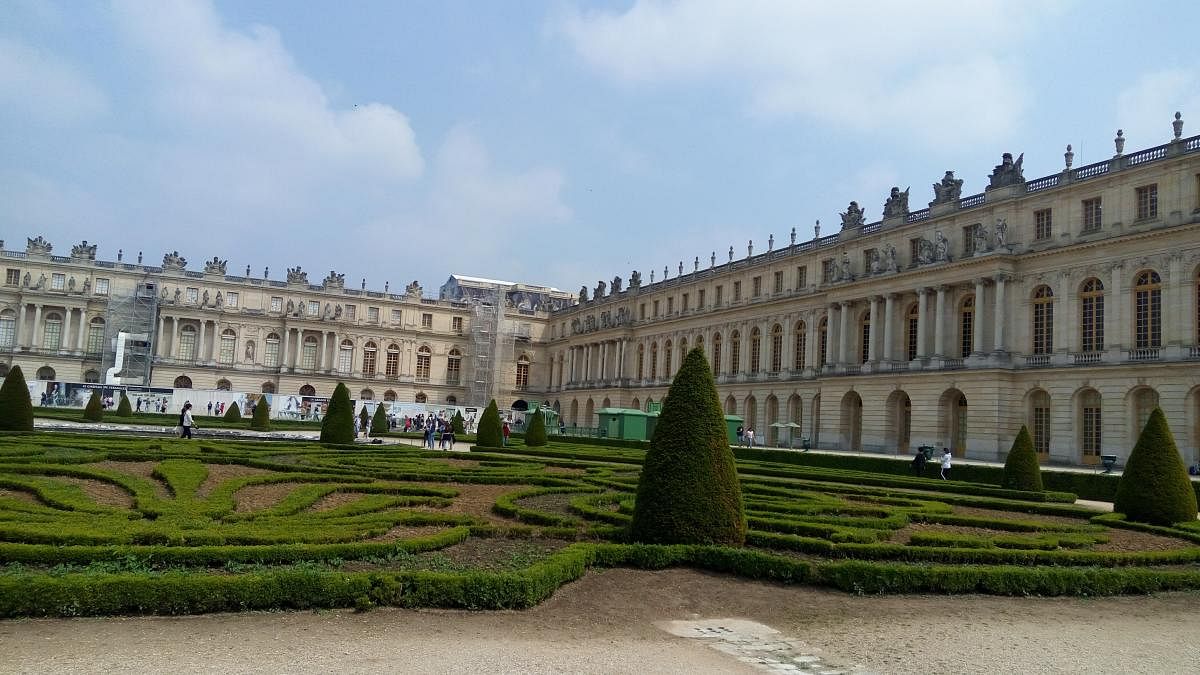

If you are on a trip to Paris and are fond of history, then you must certainly visit the Palace of Versailles (pronounced Versai). The palace was once the royal residence of Kings Louis the XIV to Louis the XVI. It was here that the famous peace treaty was signed by Germany and the Allied Powers to end World War I. A tour of the palace and the surrounding gardens will throw light on how the French emperors lived a life of luxury, grandeur and opulence.
Versailles is situated at a distance of about 20 km from central Paris. We boarded an inter-state train to Versailles. We walked the short distance from the Train Station, through a tree-lined street that led us to the palace. At the entrance, an imposing statue of King Louis XIV sitting astride a horse welcomed us. The first view of the palace from the gate filled us with awe — the huge cobbled courtyard in the front slowly merged into an expansive double-storeyed building. Unlike any palace structure, it stood more like a large country house. In fact, it was originally constructed as a hunting lodge by King Louis XIII in 1624.
Later, his son King Louis XIV, known famously as the Sun King, took a great liking for the village of Versailles and built a huge country house here. It is for this reason that it is referred to as a Chateau. The palace contains nearly 2,300 rooms and the estate is spread across 2,500 acres of land.
After presenting our tickets, we entered the palace building and climbed up the massive stone steps to the first floor. Each room has been restored to its earlier brilliance and decorated in the same way that it originally was. The impressive paintings, the wall hangings, the life-sized sculptures, the chandeliers, the silk tapestry, the antique tables, chairs and royal seats, the brocade fabric with floral prints — every minute detail in the rooms conveyed luxury and a taste for the rich life.
As we walked from room to room, the audio guide took us through the history of the place, the kings and their families, the kind of food and wine they had and the lavish entertaining they did. The Palace housed not only the private quarters of the kings and queens but was also the seat of the royal court. The King met with his ministers and performed his royal duties. Prominent among the rooms were the Hall of Mirrors, a large room filled with 350+ mirrors on the windows of the arches, the ceiling painted with scenes depicting the glorious period of King Louis XIV. The royal chapel is also a beautiful two-storeyed construction and the architecture is awe-inspiring. We passed through several rooms named after Roman Gods — the Hercules Room, the Hall of Plenty — where refreshments like coffee, wine and liqueur were served — the Venus Room, the Diana Room, the Apollo Room — which served as the throne room — the Mercury Room, the Mars Room. All the rooms had distinguishing murals and sculptures that highlighted the Gods they were named after and also depicted the life and times of the French emperors, their conquests both on the battlefield and on the world economies.
After a good 3 hours inside the palace rooms, we then made our way to the gardens. They are beautifully maintained with fountains and water bodies, white marble sculptures of men, women, children, nymphs and lions, placed across the lawns, lending an antique and aesthetic appeal. We took the buggy cart to visit the smaller residences within the estate, namely the Grand Trianon, the Petit Trianon. These are smaller cottages built within the estate — smaller in size but certainly no less regal in its decoration and fittings. They were used at various points by the kings as a family retreat and also later by the queens or the king’s mistresses.
Queen Marie Antoinette stayed in the Petit Trianon — it was gifted to her by King Louis XVI. The courtyard, the beautiful gardens surrounding these little palaces, the orange orchards are simply out of the world. The day trip to Versailles from Paris is certainly a fascinating one — it is a remarkable walk through the pages of French history.